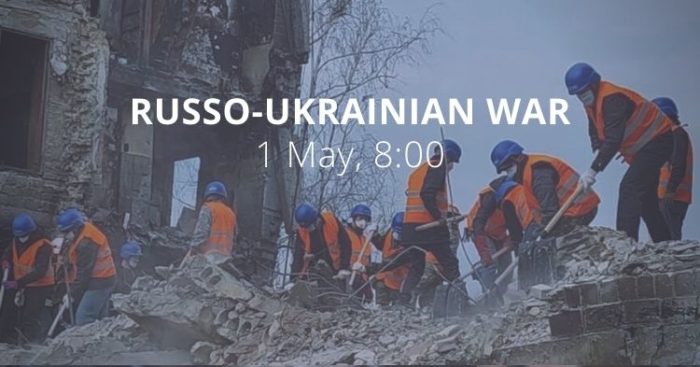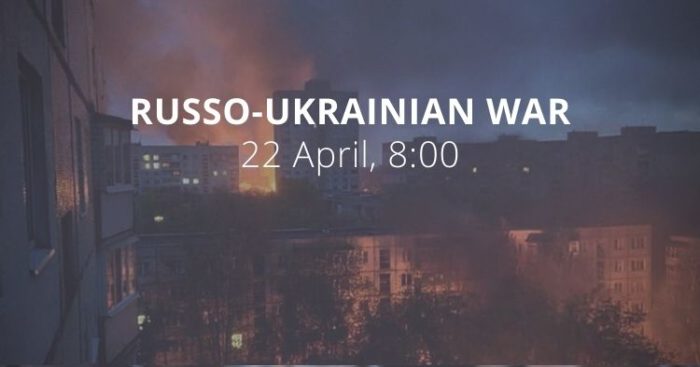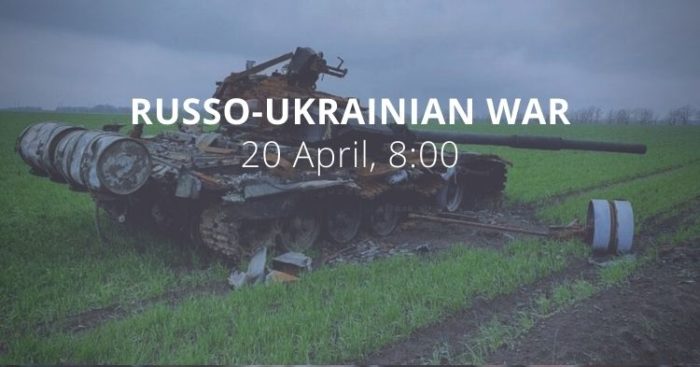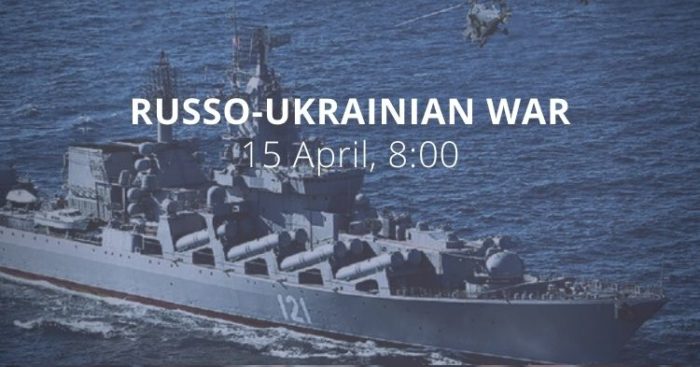Morning report day 67 – May 01
Situation
According to information from the General Staff:
In the Volyn and Polissya directions, Russian forces did not take active action. There have been no significant changes in the situation in these areas. In the Siversky direction, Russian forces units fired on the positions of our troops from the territory of the Bryansk Oblast. In the Slobozhansky direction, the Russian forces continue to carry out airstrikes and artillery fire on Kharkiv. The occupiers are conducting offensive operations in the directions of Izium - Barvinkove and Izium - Sloviansk. The forces' strike group continues to strengthen. Up to 300 weapons and military equipment were transferred to certain areas, and about a thousand mobilized persons arrived from the temporarily occupied territories of Donetsk and Luhansk oblasts. In the Donetsk and Tavriya directions, groups of Russian forces troops are conducting active operations along the entire section of the line of contact. The forces are trying to carry out airstrikes and artillery fire on the positions of our troops. In the Pivdenny Buh direction, Russian occupiers’ forces of the 8th and 49th Combined Arms Armies, the 22nd Army Corps, the coastal units of the Black Sea Fleet of the Southern Military District, and airborne troops are fighting to improve their tactical position. The forces continue to regroup units, and take measures to replenish supplies. The previous day, the air defense units hit nine air targets: two Su-25 aircraft and seven UAVs. As a result of the offensive of the Ukrainian Defense Forces in the Kharkiv oblast, control over the settlements of Verkhnya Rohanka, Ruska Lozova, Slobidske and Prilesne was restored.” 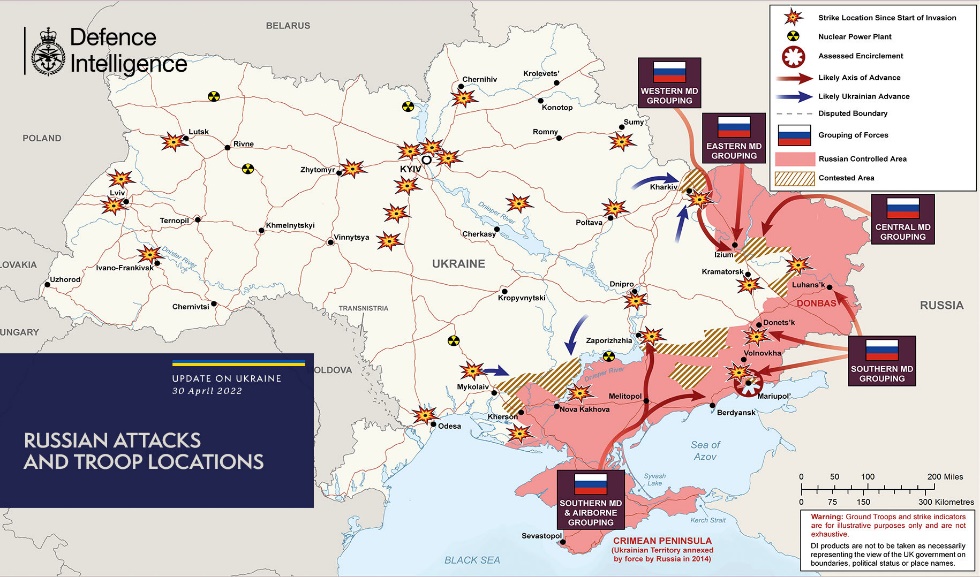 To increase the pace of the offensive operation, the command of the armed forces of the Russian Federation continues to take measures to strengthen the strike potential of its troops. Weapons and military equipment removed from storage in the Western, Central, and Eastern Military Districts and the Northern Fleet are transferred to the border areas with Ukraine by rail.
To increase the pace of the offensive operation, the command of the armed forces of the Russian Federation continues to take measures to strengthen the strike potential of its troops. Weapons and military equipment removed from storage in the Western, Central, and Eastern Military Districts and the Northern Fleet are transferred to the border areas with Ukraine by rail.
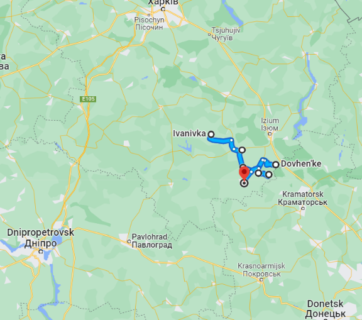 Russian forces continue to concentrate forces and resources both in the temporarily occupied territories of the Kharkiv oblast and in the Belgorod Oblast, near the state border of Ukraine. Thus, the occupiers moved units of the 55th Independent Motorized Rifle Brigade of the 41st Combined Arms Army of the Central Military District to the Volokhiv Yar settlement and units of the 5th Independent Tank Brigade of the 36th Combined Arms Army of the Eastern Military District to Izium.
Russian forces continue to concentrate forces and resources both in the temporarily occupied territories of the Kharkiv oblast and in the Belgorod Oblast, near the state border of Ukraine. Thus, the occupiers moved units of the 55th Independent Motorized Rifle Brigade of the 41st Combined Arms Army of the Central Military District to the Volokhiv Yar settlement and units of the 5th Independent Tank Brigade of the 36th Combined Arms Army of the Eastern Military District to Izium.
Russian troops prepare to intensify the offensive in eastern Ukraine, Ukrainska Pravda reports. Oleksandr Motuzianyk, a spokesman for the Ministry of Defense of Ukraine, noted that Russian troops are gradually intensifying the offensive in the east of Ukraine on all fronts at once. They are most active on the Slobozhanskyi and Donetsk fronts. In addition, there are indications – such as certain preparatory measures undertaken by Russian troops – that Russia is getting ready to further intensify hostilities. For example, Russian troops are freeing up hospital beds in Balakliia Central District Hospital and have set up an additional field hospital. Meanwhile, additional refrigerated chambers for storing bodies of military personnel killed in battle have been installed at the military hospital in the Russian city of Rostov-on-Don.
Army destroys Russian EW system, two drones, over 40 invaders in southern Ukraine, the Ukrinform reports. The Armed Forces of Ukraine have destroyed a Russian Repellent-1 electronic warfare system, three anti-aircraft guns, a Strela-10 missile system, a communications vehicle, and 42 invaders. The Operational Command South said this on its Facebook page, according to Ukrinform.
In addition, another attack on forces targets on Zmiinyi (Snake) Island destroyed three anti-aircraft guns, a Strela-10 anti-aircraft missile system, and a communications vehicle. On April 30, Russian invaders again launched a missile strike on Odesa. Three Oniks missiles fired from the occupied territory of Crimea by a Bastion missile system hit the airport's runway.”
Russian special services were preparing a revolt in Odesa through criminals in their control, Ukrainska Pravda reports. The Russian special services were preparing provocations and riots in Odesa for the anniversary of the tragic events of 2 May 2014.
“During searches of the criminals' base, law enforcement officers seized a large number of firearms, prohibited symbols of the Soviet regime, grenades, ammunition, instructions for infiltrators and brochures. A video made by law enforcement officers shows that many brochures mention the deaths that occurred in the centre of Odesa on 2 May. A curfew will be imposed in Odesa from the evening of 1 May to the morning of 3 May, due to the possible threat of shelling and provocations by the Russian occupiers. Trains running through railway stations in the city have also been cancelled.”
According to British Defense Intelligence, (last 24 hours):
- Since seizing the southern city of Kherson in early March, Russia has sought to legitimize its control of the city and surrounding areas by installing a pro-Russian administration.
- Recent statements from this administration include declaring a return to Ukrainian control “impossible” and announcing a four-month currency transition from the Ukrainian hryvnia to the Russian rouble. The Russian rouble is due to be used in Kherson from today.
- These statements are likely indicative of Russian intent to exert strong political and economic influence in Kherson over the long term.
- Enduring control over Kherson and its transport links will increase Russia’s ability to sustain its advance to the north and west and improve the security of Russia’s control over Crimea.
As of Sunday 01 May, the approximate losses of weapons and military equipment of the Russian Armed Forces from the beginning of the war to the present day: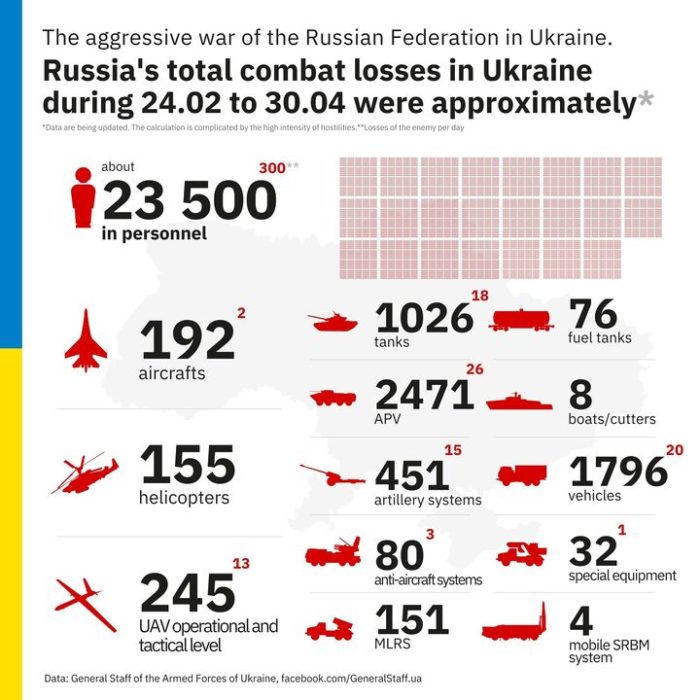
- Personnel – more than 23500 people (+300),
- Tanks – 1026 units (+18),
- Armored combat vehicles – 2471 units (+26),
- Artillery systems – 451 (+15),
- Multiple rocket launchers – 151 (+0)
- Air defense means – 80 (+3),
- Aircraft - 192 (+2),
- Helicopters - 155 (+0),
- Automotive technology – 1721 (+20),
- Vessels/boats - 8 units (+0),
- Fuel and lubricant tanks – 76 (+0),
- UAV operational and tactical level – 245 (+13)
- Special equipment – 32 (+0)
- Mobile SRBM system – 4 (+0)
- Cruise missiles - 84
Humanitarian
A small group of women and children has made it out of Mariupol’s Azovstal steel plant, The New York Times reports.
The sprawling Azovstal plant has become the last refuge for thousands of trapped Ukrainian fighters and civilians. Russian soldiers control the rest of the city, and fighting has continued around the plant. Ukrainian officials have been pleading for a cease-fire to allow evacuations, saying there is little food or water left inside and time is running out. Efforts to establish safe evacuation corridors have been repeatedly foiled by Russia’s continued shelling.”
20 civilians evacuated from Azovstal, but wounded soldiers were ignored – Azov Ukrainska Pravda reports. Deputy Commander of the Azov Regiment Sviatoslav Palamar ("Kalyna") said that Ukrainian fighters had rescued 20 civilians from the ruins at Azovstal and handed them over for evacuation to Ukrainian-controlled territory. Right now the Azov Regiment is carrying out a special rescue operation in which we are rescuing civilians from under the rubble. We hope that the process will continue, and we will be able to evacuate all the civilians. Regarding the wounded. These are people who need medical care, but we do not know why they are not being taken away and there is no question of their evacuation to the territory controlled by Ukraine.
Another exchange of the prisoners of war took place on April 30. 7 defenders of Ukraine and 7 civilians (among them a pregnant woman) were returned home. 14 people in total.
According to UNHCR 5,468,629 refugees have been registered as of April 29. The UN says that so far Poland has taken in 3,014,157 refugees, Romania 817,303, Russian Federation 656,381, Hungary 519,979, Republic of Moldova 443,559, Slovakia 371,918 and Belarus 25,002. Among those who fled Ukraine are also Ukrainian nationals with dual citizenship. An additional 105,000 people moved to the Russian Federation from the Donetsk and Luhansk oblasts between 18 and 23 February.
The number of Ukrainians entering Ukraine since February 28 is 1,289,500 as of April 29. This figure reflects cross-border movements, which can be pendular, and does not necessarily indicate sustainable returns.
OHCHR recorded 6,134 civilian casualties in Ukraine as of April 28. 2,899 were killed (including 210 children) and 3,235 injured (including 309 children).
Environmental
Russians steal grain in the occupied territories, the Economic Truth reports. Russian occupiers steal grain from Ukrainian farmers in the temporarily occupied territories of Ukraine. The Minister of Agrarian Policy and Food, Mykola Solskyi, told about this in an interview with «Настоящее время», the press service of the Ministry of Agriculture reports.
Such cases occur everywhere in the occupied territories, he added, noting that a special surge has been observed over the past two weeks. "All this is reminiscent of the thirties of the last century and once again shows the true face of the Russian aggressor," he said. Accordingly, according to the Minister, such a situation could threaten certain food problems in the temporarily uncontrolled territories. "There will be a wheat harvest in the south soon. But farmers in this situation may well say, 'Here are the keys to the tractor - go and collect it yourself, if you want,'" he said.”
On April 30, Russian occupiers abducted Viktor Pendalchuk, the director of the Secondary School of the 1st-3rd grades in Kakhovka, Kherson Oblast
Locals said he refused to cooperate with Russian occupiers https://t.co/VxamNegx2Q pic.twitter.com/xTiuKeCeol
— Euromaidan Press (@EuromaidanPress) May 1, 2022
Legal
Kyiv police find another mass grave in Bucha with ‘signs of torture, the independent reports.
They were found with their hands tied behind their backs, and some of them were gagged. They also had several gunshot wounds, according to Kyiv regional police chief Andriy Nebytov. He said in a YouTube video that the injuries indicate that the men had been tortured, adding: “Finally, each of the men was shot in the ear.” The men’s clothes showed they were civilians, Mr. Nebytov said. Their identities were not known as their faces had been disfigured by torture, he also said. Forensic laboratories have now examined a total of 1,202 bodies of civilians believed to have been killed by Russian occupiers in the Kyiv Oblast, Mr. Nebytov claimed."
According to the General Staff of Ukraine:
- Russian occupation forces continue to carry out illegal actions in the occupied territories of the Kharkiv Oblast. According to available information, Russian forces are forcibly deporting the population to the territory of the Russian Federation. Russian occupiers are spreading misinformation about the capture of Kharkiv, Kyiv, and Zaporizhzhia.
- Russian forces are launching missile and bomb attacks and carrying out artillery shelling of civilian infrastructure and residential areas in the settlements of Zaporizhzhia, Dnipropetrovsk, Donetsk, Luhansk, and Kharkiv oblasts.
Armed Forces shared a video that shows Chernihiv city after Russia's bombardments
"There is no hospital left that hasn't been damaged. 3 medical institutions of 5 were ruined with no possibility of rebuilding them," the deputy chief of the Health Department said on April 30 pic.twitter.com/eXNu3Z3EwN— Euromaidan Press (@EuromaidanPress) May 1, 2022
- Russian forces also continue to illegally detain Ukrainian citizens and torture and torment them.
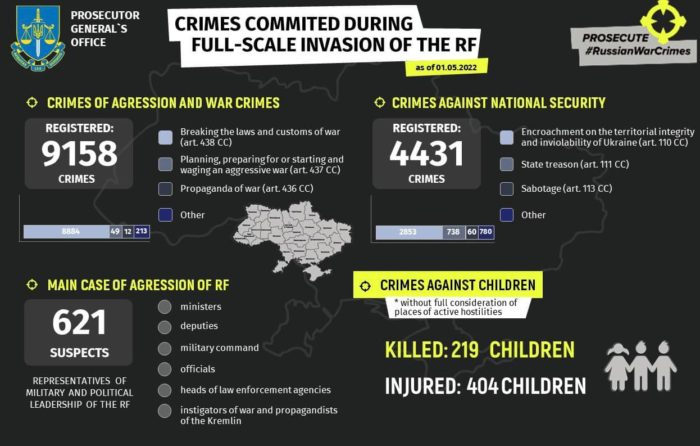 219 children were killed, and 404 children injured, the Office of the Prosecutor General of Ukraine reports as of May 1. 1,570 educational establishments are damaged as a result of shelling and bombings, 111 of them are destroyed fully. 9,158 crimes of aggression and war crimes and 4,431 crimes against national security were registered.
219 children were killed, and 404 children injured, the Office of the Prosecutor General of Ukraine reports as of May 1. 1,570 educational establishments are damaged as a result of shelling and bombings, 111 of them are destroyed fully. 9,158 crimes of aggression and war crimes and 4,431 crimes against national security were registered.
Support
Denmark will hand over to Ukraine the Piranha III armored personnel carrier, heavy mortars, and shells to them, the Ukrainska Pravda reports.
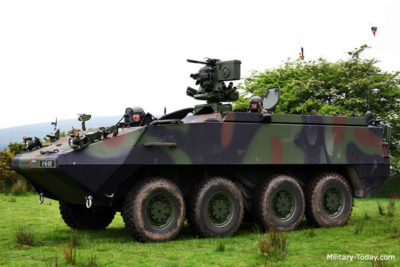
This was reported by the Danish newspaper OLFI. According to the publication, Ukraine will receive 25 armored personnel carriers in the 8x8 version. Piranha is a family of wheeled armored personnel carriers developed by the Swiss company MOWAG. It is one of the most popular armored platforms in the world. Now the Danish army is rearming the Piranha V armored personnel carrier. It is also reported that Denmark will hand over 50 M113 tracked armored personnel carriers and M10 heavy mortars, along with thousands of mortar shells for them. The M113 armored personnel carrier has been used by the Danish army since 1964 but has been upgraded several times.
Britain to give Ukrainians equipment they need to defend themselves – Johnson, the Ukrinform
reports.
“Britain will continue to support Ukraine in its fight against Russian occupiers. UK Prime Minister Boris Johnson said this on his Twitter account, Ukrinform reports. Johnson said that he had a conversation with Ukrainian President Volodymyr Zelenskyy and assured him that the UK will continue to provide military and humanitarian aid to give Ukrainians the equipment they need to defend themselves in their fight against Russian invaders.”
France promises to increase military and humanitarian aid to Ukraine, the Euronews reports.
“President Emmanuel Macron said France would step up military and humanitarian support to Ukraine during a phone call with Ukrainian President Volodymyr Zelenskyy on Saturday, Paris said. Macron reiterated his “strong concern” over Russia’s bombing of Ukrainian cities and the “unbearable situation” in the southeastern Ukrainian port city of Mariupol, the French presidency added in its statement.”
New developments
1. Ukraine plans to fill in the second part of the EU membership questionnaire before the end of next week, the Ukrinform reports. "The European Union has already examined the part of the documents we submitted. There were no additional questions, our work was appreciated quite highly. We carried out the reforms described there together with our partners, so we already closed that part of the work. Now we prepare to submit the whole book of our statehood to the European Union by the end of next week, Deputy Prime Minister for European and Euro-Atlantic Integration of Ukraine Olha Stefanishyna said during the nationwide telethon, an Ukrinform correspondent reports.”
2. The West has openly chosen the strategy of conducting proxy wars against Russia and this policy is fraught with very serious consequences, the TASS alleges. “Russia calls on other states to abide by the logic sealed in documents for preventing nuclear war and strictly follows the principle that such a conflict is inadmissible, Director of the Foreign Ministry’s Department for Non-Proliferation and Arms Control Vladimir Yermakov told TASS on Saturday. "It is imperative to reaffirm the principle that the risks of a nuclear war that must never be unleashed must be minimized, in particular, by way of preventing any armed conflict between nuclear powers. Russia strictly abides by this principle," he emphasized. ME: A crucial element of the Russian “fait accompli strategy” where it invades a foreign country, only to threaten nuclear war in case the international community intervenes.
3. Russia says strategic stability dialogue with US 'frozen,' the Reuters reports. Dialogue between Moscow and Washington on strategic stability is formally "frozen", the TASS news agency cited a Russian foreign ministry official as saying on Saturday. Vladimir Yermakov, the foreign ministry's head of nuclear non-proliferation, said those contacts could be resumed once Russia completes what it calls its "special military operation" in Ukraine.
4. The E.U. is weighing a lengthy phase-out for Russian oil, The New York Times reports. “The European Union will likely give its members until the end of 2022 to completely ban Russian oil imports, officials involved in the talks said Saturday. The bloc has been mulling how to ban Russian oil without unleashing carnage on either the E.U. economies that depend on it or the global oil market. Such a move would send global oil prices up and affect not only European and American consumers but also the most vulnerable people in the developing world. The objective, said officials who are participating in intensified talks to finalize the measure by the end of next week, is to permit the global oil price to adjust to the new reality. The officials spoke on condition of anonymity because negotiations were ongoing, and they did not have clearance to brief journalists on the record.”
5. Russian plane violated Swedish airspace, military says, the Washington Post reports. “The Swedish armed forces said a Russian plane briefly violated the country’s airspace on Friday night. The military said in a statement on Saturday that the plane was an AN-30, which is described by its manufacturer, Russian state-owned Antonov, as a specialized aerial survey plane. The plane violated Swedish airspace for a “short period” near Blekinge, on the southern tip of Sweden, before leaving, the military said.”
Assessment
On the War
The Institute for the Study of War has made the following assessment as of Saturday 30 April:
Several successful Ukrainian counterattacks out of Kharkiv city in the last 72 hours have additionally recaptured a ring of suburbs north and east of the city and may additionally force Russian forces to redeploy units intended for the Izium axis to hold these positions. Russian forces appear increasingly unlikely to achieve any major advances in eastern Ukraine, and Ukrainian forces may be able to conduct wider counterattacks in the coming days.
Russian forces remaining in Mariupol, including elements of the 810th Naval Infantry Brigade, continued to block Ukrainian troops in the Azovstal Steel Plant and carried out airstrikes on April 30. Occupying Russian forces are intensifying occupation measures through Mariupol.
Russian forces continued unsuccessful attacks alongside artillery fire and airstrikes on the entire Donetsk-Luhansk frontline and did not make any confirmed advances on April 30. The Ukrainian General Staff stated that Russian forces aim to capture Rubizhne and Popasna and use these towns as springboards for further advances west toward Lyman and Sloviansk. Russian forces around Izium are attempting to capture these towns from the north to merge Russian advances in eastern Ukraine, but Ukrainian forces are successfully preventing Russian forces from making major gains on either axis.
Russian forces continued to attack southeast and southwest from Izium but did not secure any confirmed advances in these directions on April 30. Ukrainian sources claimed an artillery strike on a Russian command post near Izium killed Russian Major General Alexei Simonov on April 30, although ISW cannot confirm preliminary reporting at this time.
Ukrainian forces continued counterattacks against several positions along an arc spanning from the north to the east of Kharkiv City and recaptured Verkhnya Rohanka, Ruska Lozova, Slobidske, and Prelesne. Ukrainian troops have recaptured a ring of suburbs around the east of Kharkiv City in the past 72 hours which may allow them to alleviate pressure on residential areas of the city, such as Saltivka, that have been targeted by intensive Russian shelling. Ukrainian counterattacks may additionally force Russian forces to redeploy units intended to support the Izium axis. Russian forces continued to bombard Kharkiv City with air and artillery strikes throughout April 30.
Russian forces continued to prioritize improving their tactical positions and shelling Ukrainian positions on the Southern Axis but did not make any confirmed advances on April 30.
Key Takeaways
- A Ukrainian counteroffensive out of Kharkiv City will likely alleviate pressure on parts of the city that have suffered the most from Russian shelling and may force Russian troops from Izium to re-deploy northward to support forces maintaining the partial encirclement of Kharkiv.
- Additional Russian forces are deploying to the Izium front but are unlikely to enable any major advances.
- Russian troops did not make any confirmed advances to the southwest or southeast of Izium or to the west of the Donetsk-Luhansk frontline.
- Russian forces in Kherson are pausing major offensive operations to improve their tactical positions and regroup to prepare for a renewed offensive to capture the administrative borders of Kherson.
- Russian occupation forces in Mariupol announced plans to consolidate their control over the city and intend to return Ukrainian citizens forcibly deported into Russia at some point in the future.“
Putin's invasion of Ukraine is of 'most depraved sort,' Pentagon says, the Reuters reports. Pentagon spokesman John Kirby on Friday accused Russian President Vladimir Putin of depravity and brutality in his two-month-old invasion of Ukraine. "It's the brutality of the coldest and the most depraved sort," Kirby told reporters. "I don't think we fully appreciated the degree to which he would visit that kind of violence and cruelty and as I said depravity, on innocent people, on non-combatants, on civilians, with such utter disregard for the lives he was taking," he said.
Ukrainian Official Outlines Intentional Ambiguity on Strikes Inside Russia, The New York Times reports. The strikes have been one of the most intriguing new elements of the recent fighting. But when it comes to confirming their origins, “we don’t say yes and we don’t say no,’’ said the official.
A fuel depot in Russia burst into flames, moments after surveillance video captured the bright streaks of rockets fired from low-flying helicopters. A fire broke out at a military research institute near Moscow. Additional fuel tanks have exploded. These and other similar attacks in Russia have been some of the most intriguing, and opaque, military developments in the last month of the war. If carried out by Ukraine, they represent acts of once nearly unimaginable audacity; one of them prompted the first air raid siren on Russian soil since World War II.
Russia has accused Ukraine of carrying out the helicopter strike and military analysts have suggested that Ukrainian sabotage is very likely responsible for the other fires. Ukraine, for its part, has made no official admissions but instead has winked at the possibility of its involvement, with one official suggesting the fires were just Russia’s bad “karma.”
Now, a senior Ukrainian official has described in the clearest terms yet his government’s policy on strikes inside Russia, calling it one of strategic ambiguity. “We don’t confirm, and we don’t deny,” said the official, Oleksei Arestovych, an adviser to President Volodymyr Zelenskyy’s chief of staff. …
Any escalation of attacks on Russia by Ukraine could have far-reaching implications, perhaps influencing public opinion about the war in Russia, or inflaming the Kremlin to the point of escalating its own strikes.
If Western weaponry were deployed in striking Russia, it would fuel Russian propaganda that blames the West for the war and enhance the possibility that the conflict could spill past Russia and Ukraine’s borders.
The fires at Russian military sites, beginning with the April 1 helicopter assault on the fuel depot in Belgorod, about 15 miles from the Ukrainian border, have injected a new element into the military equation of the war. They raise the possibility that Russia, after weeks of inflicting devastating damage in Ukraine, might start to suffer losses on its own land.
https://twitter.com/EuromaidanPress/status/1520755850054356993?s=20&t=4vMs2XEITfiF3pfz7lbfBw
The strikes come in two forms: the clear military attack with low-flying helicopters near the border, and sabotage deeper inside Russia
.
Russian and Ukrainian media reports have attributed a dozen or so blazes to strikes or sabotage. In addition to the helicopter strike, there have been at least three other fires at military sites that seem suspicious, and which military analysts have said were very likely set intentionally. …
The incidents have stirred debate over whether a wider set of targets in Russia may drive home to the Russian people that the war, seen for now only on television and filtered through state propaganda, has a cost at home.
Alternatively, the fires and explosions might cause Russians to rally around the flag in ways damaging to Ukraine, such as by building support for a general mobilization in Russia. That would enable the Kremlin to dispatch more soldiers to the battlefields, despite heavy losses so far. …
Kyiv has also signaled that any counterattacks in Russia are simply part of a war Russia started, and asked, perhaps fatalistically, what more could Russia do to Ukraine? After all, the Russian army is already engaged in a full-scale assault.
“If you decided to attack another country, commit mass murder, crush peaceful people with tanks, and support murder using warehouses in your region, then sooner or later the time will come to repay that debt,” said Mykhailo Podoliak, a negotiator for President Volodymyr Zelesnkyy.“…
So far, Ukraine has received public support from Britain for directly attacking Russia, with James Heappey, an official in the Foreign Secretary’s Office, saying the strikes were “completely legitimate” given the role of fuel and ammunition depots in Russia’s invasion of Ukraine. Mr. Heappey also endorsed the use of British-supplied weaponry, saying its use to strike inside Russia was “not necessarily a problem.”
The Russian military, which has been firing missiles and artillery at Ukrainian cities and military targets including fuel depots, continuously for two months now, warned on April 13 against Ukraine striking back. The ministry spokesman, Igor Konashenkov, told Russian news agencies that Russia would respond by targeting the Ukrainian leadership. …
Three major fires inside Russia followed that warning, including near Moscow, at a military research institute in the city of Tver. In the Ukrainian military, the arson fires and helicopter assaults into Russian territory have also served the purpose of lifting morale. Having seen the effectiveness of their small unit tactics against the Russian army in the battle for Kyiv in March, mid-level Ukrainian commanders have suggested continuing this strategy inside Russia.
“It will not end until we bring the war to Russia,” said the commander of a Ukrainian brigade, who asked that he be identified only by his nickname, Akula, because he was not authorized to speak publicly. “It’s not a secret that the Russian people support the war, that it is not just Putin and the rest of the Russians are peaceful,” he said. We need to make Russian society fear” attacks on their own country to shift perceptions, he said. They need to send people like me to Russia.”
Consequences and what to do?
Defeating Putin will require larger US commitments — and risks, the Editorial Board of the Washington Post argues.
The Russian war on Ukraine that many experts expected to last less than a week has entered its third month — a good time to take stock of both the results so far and the plans of the United States and its allies for what comes next. On the first point, there is much that is positive. Thanks largely to the courage and dedication of the Ukrainian people and armed forces, Russia has not only been denied swift victory but also driven back from the capital, Kyiv, and forced to regroup and concentrate its offensive efforts on Ukraine’s east and south. The United States and its NATO allies have pivoted from a strategy premised on the likelihood of rapid Russian victory to one aimed at aiding Ukraine’s surprisingly sustained fight, and — thwarting one of Russian President Vladimir Putin’s aims — the alliance has remained united. Not only that, it has toughened its stance on economic sanctions, with even reluctant Germany preparing to support a ban on Russian oil imports. Far from splitting under Russian pressure, NATO might soon actually grow, with the likely inclusion of Finland and Sweden.
And yet a longer, more costly military struggle looms. Russia’s aim is to push westward from its redoubts in Crimea and Donbas, eventually breaking through and encircling Ukrainian forces. Stopping this is the reason Ukraine needed an immediate infusion of heavy weaponry; actually enabling Ukraine to go on the counteroffensive later this spring and summer is the reason it will need still more in the coming weeks.
Thus, President Biden’s request for $33 billion in new aid for Ukraine, of which $20 billion will be military, was not only appropriate but urgent, and Congress should respond accordingly. Coupled with the recent approval of a revived “lend-lease” system, Mr. Biden’s proposal puts the United States in position to bolster Ukraine over the long haul.
With long-term commitment comes long-term danger. As the complexity of Mr. Putin’s situation, military and political, grows, so does his inclination to simplify it through even greater use of force — or threats thereof. Hence Moscow’s recent attempts at energy blackmail against Europe, its rhetorical recasting of the war as a proxy battle between Russia and NATO, and its hints at the use of nuclear weapons. Mr. Putin’s own remark on Wednesday that Russia would make a “lightning-fast” response to “unacceptable” outside intervention is the sort of vague threat the United States can neither give in to nor ignore.
When past US policy has failed in Ukraine, it was often because fearing to provoke Mr. Putin, it did not do enough to deter him. Obviously, the Biden administration must not err in the opposite direction now. But the record of the war so far, including Europe’s admirable determination to seek new energy sources, vindicates a policy of maximum firmness. Mr. Putin’s war aim is not merely to conquer Ukraine but to overthrow the international order itself. It’s worth accepting costs and taking risks to make sure that Russia fails — and emerges from the conflict unable to wage such aggression again.

